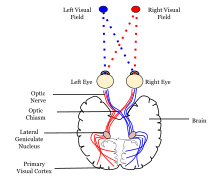
Back مسار عصبي Arabic Nervenbahn German Vía neural Spanish Hermorata Finnish Voie neuronale French 신경 경로 Korean Neironu ceļš Latvian/Lettish Нервен пат Macedonian Baan (zenuwstelsel) Dutch วิถีประสาท Thai

In neuroanatomy, a neural pathway is the connection formed by axons that project from neurons to make synapses onto neurons in another location, to enable neurotransmission (the sending of a signal from one region of the nervous system to another). Neurons are connected by a single axon, or by a bundle of axons known as a nerve tract, or fasciculus.[1] Shorter neural pathways are found within grey matter in the brain, whereas longer projections, made up of myelinated axons, constitute white matter.
In the hippocampus, there are neural pathways involved in its circuitry including the perforant pathway, that provides a connectional route from the entorhinal cortex[2] to all fields of the hippocampal formation, including the dentate gyrus, all CA fields (including CA1),[3] and the subiculum.
Descending motor pathways of the pyramidal tracts travel from the cerebral cortex to the brainstem or lower spinal cord.[4][5] Ascending sensory tracts in the dorsal column–medial lemniscus pathway (DCML) carry information from the periphery to the cortex of the brain.
- ^ Moore, Keith; Dalley, Arthur (2005). Clinically Oriented Anatomy (5th ed.). LWW. p. 47. ISBN 0-7817-3639-0.
A bundle of nerve fibers (axons) connecting neighboring or distant nuclei of the CNS is a tract.
- ^ Witter, Menno P.; Naber, Pieterke A.; Van Haeften, Theo; Machielsen, Willem C.M.; Rombouts, Serge A.R.B.; Barkhof, Frederik; Scheltens, Philip; Lopes Da Silva, Fernando H. (2000). "Cortico-hippocampal communication by way of parallel parahippocampal-subicular pathways". Hippocampus. 10 (4): 398–410. doi:10.1002/1098-1063(2000)10:4<398::AID-HIPO6>3.0.CO;2-K. PMID 10985279. S2CID 25432455.
- ^ Vago, David R.; Kesner, Raymond P. (2008). "Disruption of the direct perforant path input to the CA1 subregion of the dorsal hippocampus interferes with spatial working memory and novelty detection". Behavioural Brain Research. 189 (2): 273–83. doi:10.1016/j.bbr.2008.01.002. PMC 2421012. PMID 18313770.
- ^ Purves, Dale (2011). Neuroscience (5. ed.). Sunderland, Mass.: Sinauer. pp. 375–378. ISBN 9780878936953.
- ^ Purves, Dale; Augustine, George J.; Fitzpatrick, David; Katz, Lawrence C.; LaMantia, Anthony-Samuel; McNamara, James O.; Williams, S. Mark (1 January 2001). Damage to Descending Motor Pathways: The Upper Motor Neuron Syndrome. Sinauer Associates.